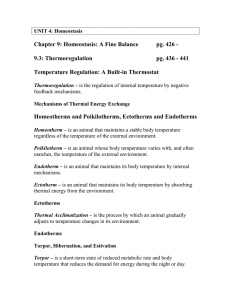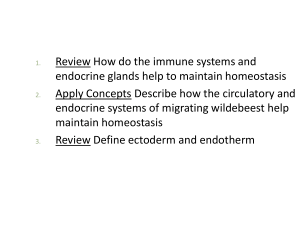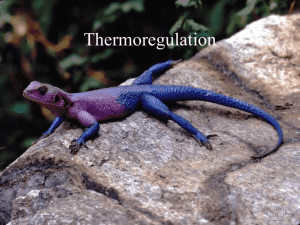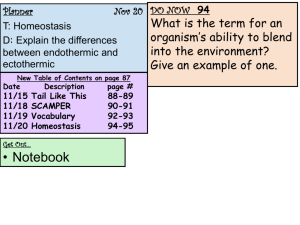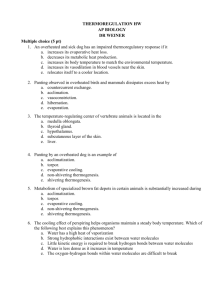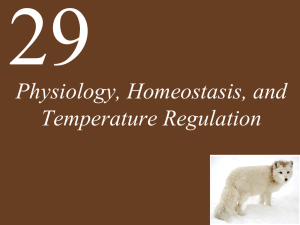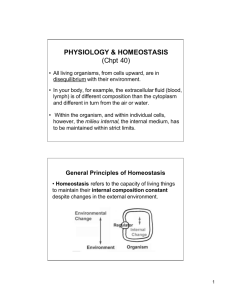HOMEOSTASIS & TEMPERATURE REGULATION
advertisement
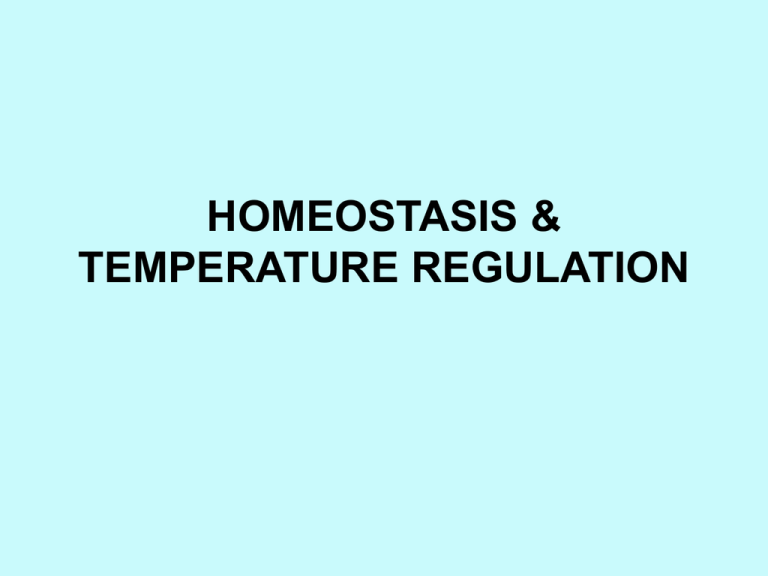
HOMEOSTASIS & TEMPERATURE REGULATION Importance of Constant Internal Environment • HOMEOSTASIS is defined as: the maintenance by an organism of a constant internal state, regardless of external environmental change • This is essential so that an organism’s systems can function efficiently • TWO STEPS are essential in achieving homeostasis: 1. DETECT the change 2. COUNTERACT the change Variables which are kept constant • Temperature • pH • Concentration of reactants • Water & salt concentration • Toxins Two Stages of Homeostasis • DETECTING CHANGE • COUNTERACTING CHANGE Role of the Nervous System Indicate on this diagram where FEEDBACK takes place in the STIMULUS-RESPONSE pathway. Thermoregulation in Humans Annotate the diagram to show how temperature is regulated in humans Feedback Mechanisms • http://www.johnwiley.net.au/highered/interacti ons/media/Foundations/content/Foundations/h omeo2c/bot.htm • Try this click & drag activity to test your understanding of feedback loops Temperatures life is found in Life in general can be found across a BROAD range of temperatures on Earth, while individual species can only withstand narrow limits Hyperthermophilic Microbes Pyrolobus fumarii grows best at 106⁰C and can withstand temperatures up to 113⁰C Terrestrial Thermophiles Cataglyphis bicolor - A heat tolerant insect in Sahara that can maintain a core body temperature of 56⁰C Hypothermophilic Organisms Algae, bacteria and lichen found at environments from -17⁰C to 20⁰C Arctic Fox can survive in temperatures as cold as -70⁰C; uses countercurrent exchange to assist this. Endotherms & Ectotherms ENDOTHERMS endo- meaning ‘within’ So, an animal which …. ECTOTHERMS ecto- meaning ‘outside’ So, an animal which…. Classes of vertebrates which are endotherms are: Classes of vertebrates which are ectotherms are: Adaptations for temperature regulation BEHAVIOIURAL STRUCTURAL PHYSIOLOGICAL Organism will alter its body position in order to increase or decrease its exposure to the ambient temperature…. Physical characteristics of an organism which assist with temperature regulation- how the animal is built…. Inner body functions of an organism which contribute to the response which allows for temperature regulation …. Eg. Eg. Eg. Australian Examplesendotherms RED KANGAROO • fur • shivering • sun basking • seek shelter from the sun • lick their forelimbs • rely heavily on panting • tail pulled into the shade of the body Australian Examplesectotherms BLUE TONGUE LIZARD • During the early morning locates itself in small depressions in the open or on tree trunks • basking in the sun with its body as perpendicular as possible to the sun's rays • Throughout the day seeks cooler shadier microhabitats. • Inactive in burrows on cold days. Consider…. • What temperature is the blood of a lizard, such as the Blue-tongue when it is active? • What happens to a lizard’s blood temperature when the environment cools down? • Does an active lizard have warm or cold blood? • WHY IS IT MISLEADING TO REFER TO ECTOTHERMS AS COLD BLOODED? Hibernation Example: An echidna enters state of TORPOR during winter months when the average ambient temperature remains about 5⁰C - Torpor is a state of inactivity, when an animal is ‘sluggish’ - Echidnas enter a state of torpor every 22 days or so. - Body temperature goes down to 9⁰C - Return briefly to a body temperature of 30⁰C for about 3 days before returning to torpor. Would this adaptation be described as behavioural or physiological? What is the advantage in terms of thermoregulation for this adaptation? Advantages of Endothermy Advantages of Ectothermy
